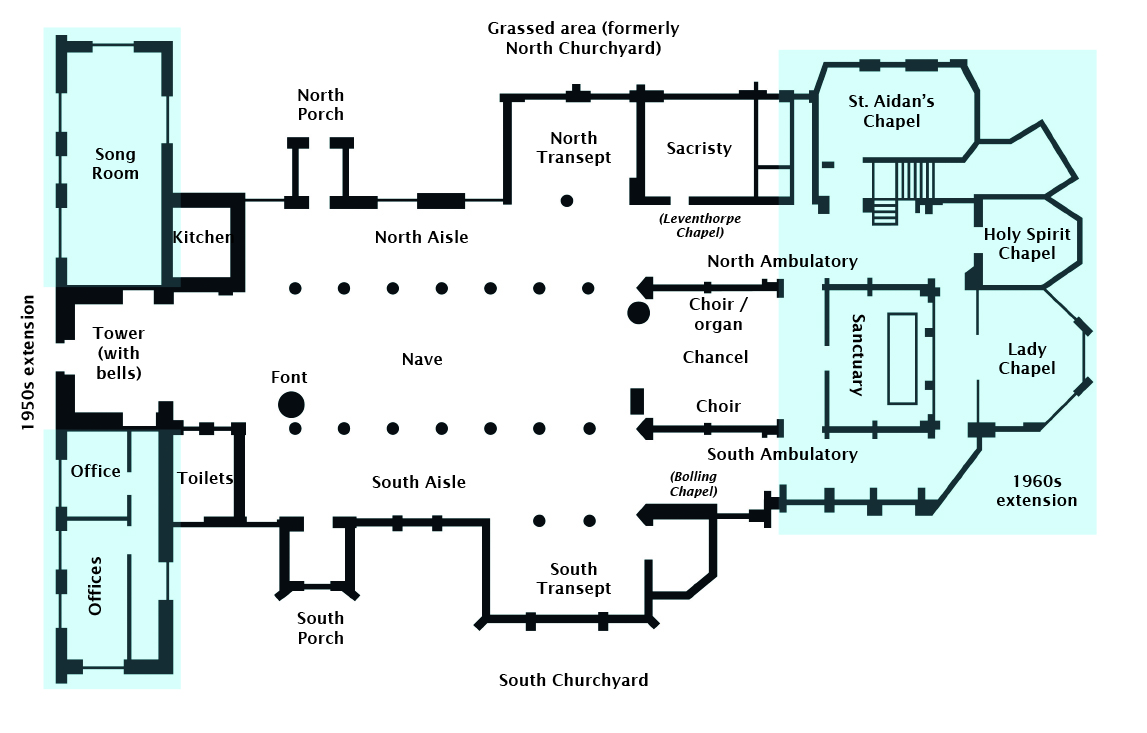Our Story
1,400 Years of History
627-633
The Broad Ford
- Likely that Christianity reaches this site as a result of Bishop Paulinus’ mission from the court of King Edwin of Northumbria. Monks come from Dewsbury to this hillside just above the “Broad Ford”
c. 633 onwards
Preaching Cross
- Preaching cross erected and later a small wooden or wattle church established here. Fragments of 2 Saxon crosses can be seen in the building
1067
Ilbert de Lacy
- In return for services to William the Conqueror, Ilbert de Lacy (born in Lassi, France) is given English land, including Bradford
1086
Domesday Book
- Domesday Book entry about Bradford: Ilbert hath it. It is waste
1096
Eldred Beany
- Records show that Eldred Beaney restored the small church
c.1200
Domesday Book
- Small stone church is built on this site
1251
The Market Charter
- Henry III grants Edmund de Lacy the right to hold a Thursday market
1277
Wool
- First record of a woollen weaver in Bradford
1281
Alice de Lacy
- Alice de Lacy gives a grant to the parish of Bradford that is recorded in the register of Archbishop Wickwayne. Also recorded is the name of the rector appointed by her, Robert Tonnington; the parish is endowed with 96 acres of land
1293
First Vicar
- Robert de Tonnington nominates Richard de Halton to the living; with the obligation “to be in personal residence”, he is regarded as the first vicar. His name is the first one on the Vicars’ Plaque inside the Cathedral
1310
Sunday Market
- Market now takes place on Sundays, in the area of the churchyard
1311
Bradford
- Estimated population of Bradford is 650 people
1311-16
Scottish Raids
- Scottish raids on Bradford and surrounding area begin; Church is destroyed by Scottish raiders. Fire blackened stones have since been found from this period underneath the present chancel
1342
Cloth Dyeing
- Earliest mention in records of cloth dyeing in Bradford
1348-49
The Black Death
- Black Death almost decimates Bradford
1360-1380
The Bolling Chapel
- Re-building works starts on the church. The Leventhorpe and then the Bolling family private chapels are among the first parts to be finished
1379
Pestilence
- Pestilence ravages Bradford and the northern counties; many inhabitants move away for a time
1408
Nave and North Aisle
- Nave and north aisle are completed
1411
South Aisle
- South aisle is completed
1455-87
Wars of the Roses
- At this time Bradford belongs to the Duchy of Lancaster so it is on the Lancastrian side
1458
The third church is completed
- Third church on this site -the present one – is completed. Much later it is extended. In 1458, the roof rests just above the arches
1466
Saint Sitha
- At this time Bradford, a market town, has a parish church and a chapel dedicated to Saint Sitha. York archiepiscopal records show a Chapel of St. Sitha built prior to 1466 near the Ive (or Ave) Bridge in Bradford
1493
The roof is raised!
- Roof is raised and the clerestory (upper part of the nave, with windows) added; building of the tower begins.
1508
The Tower
- The tower is completed. What you can see, as you look to your left and up, is what the people of Bradford would have seen in 1508
1536
- Believed to be the date of the ornate oak font canopy, which is still in the Cathedral
1548
The Rood Loft is removed
- Order for the removal of rood lofts in churches. “Rood” is an Old English word for cross or crucifix. The rood steps are still visible in the building but now they are the steps to nowhere
1588
The Spanish Armada
- Beacon fires are thought to have been lit on high ground about Bradford to give warning of the approach of the Spanish Armada
1615
Bolling Chapel Rebuilt
- Bolling Chapel on south side collapses and is re-built
1625
Bradford is sold!
- Charles 1 sells Bradford to the City of London to pay his father’s debts
Oct 1642 - Mar 1644
English Civil War
- During the English Civil War, Bradford (with Parliamentarian sympathies) is involved in 5 clashes between Royalist and Parliamentarian forces
1642-3
Battle/s of the Steeple
- Woolsacks are hung from the tower of the church as a defence against cannon fire from Royalist forces. For this reason, the woolsack is later used as a symbol on the Church’s and then the Cathedral’s crest.
1662
Bradford Grammar School
- Bradford Grammar School, located close to the church in its earliest days near the bottom of Church Bank, receives a charter from Charles II
1665
The Plague
- Bradford’s population is reduced by plague, believed to be brought by a bundle of clothing from London
1666
Bells
- Bells are hung for the first time, at the top of the tower. If you look towards the tower, you can see the louvred windows of the bell tower
c. 1666
The Clock is installed
- This is the only public clock in Bradford for many years. The workings of the clock used to be housed in a room halfway up the tower, which is now the bell ringing room
1681
Bone House is built next to the church
- The doorway can still be seen, now re-used as part of the Song Room doorway
1688
Bradfordian Abraham Sharp
- He assists Flamsteed, the first Astronomer Royal, at Greenwich Observatory. Sharp’s memorial, written in Latin, is in the Cathedral. Look out for Newton and Flamsteed’s names on the memorial
1695
Church Bank Vicarage
- Vicarage is provided in Church Bank, for the sum of £153. Previous vicars had lived in Goodmansend and probably walked to the church along nearby Vicar Lane
1705
Church is re-pewed
- There are now no pews in the building as these were taken out in the 1980s to make the space more flexible for services and events
1715
Bells increased
- Bells are re-cast and increased to 6
1724
Roof is added
- A new oak-timbered roof is added, with the timbers coming from Tong Forest. It is an impressive feature, which can still be seen today
1731
The Birthday of King George II
- Church bell-ringers are paid 6 shillings for ringing
1735
Bells
- Number of bells is increased to 8
1774
Opening of the Bradford branch of the Leeds and Liverpool Canal
- The memorial to Joseph Priestley – canal superintendent for almost 50 years and who oversaw its construction- is just inside the entrance door to the Cathedral
1781 onwards
To accommodate larger congregations, galleries are installed on all sides
- The walls are whitewashed and a false ceiling is put up; the aisle roof is raised to accommodate the galleries; a triple-decker pulpit is installed halfway down on the north side
1784
West gallery is built and an organ added to it
- It is transported from Newcastle by sea and then by canal
1788
John Wesley
- John Wesley preaches here to a crowded congregation, on his last appearance in Bradford
1797
East gallery is built and an organ added to it
- East gallery is built, across the chancel arch – the big arch closest to the altar or communion table. Lightning conductor (invented in 1752) is installed in the tower
1801
Bradford
- According to the first national census, Bradford’s population is 13,264
1810
Parish of Bradford
- Parish of Bradford covers 51 square miles, ranging from Ponden, Queensbury and Oakenshaw to Eccleshill. There is a chapel of ease at Haworth
1816
Henry Heap becomes vicar
- Heap presents Patrick Bronte to the living of Haworth
1833
South side work
- South wall is re-built; south porch is built
1839
William Scoresby Jnr
- William Scoresby Jnr, a renowned Arctic explorer and scientist, becomes vicar. He is particularly well-known for his scientific work in the fields of oceanography and magnetism. There is a plaque commemorating him in the north porch
1840
Queen Victoria’s wedding day
- Church bell-ringers are paid £2 10s for ringing
1845
Bells
- Number of bells is increased to 10
1851
Bradford
- According to the census, Bradford’s population has now grown to 103, 771
1863
First stained glass window is installed
- It was installed by Morris & Co. at the east end of the church. It features designs by Morris, Rossetti, Burne-Jones, Maddox Brown, Marshall, Webb and de Morgan. You can still see it at the east end extension
1860s
East and west galleries removed
- False plaster ceiling taken down; pulpit moved to present position
1873
Bradford Town Hall
- Bradford Town Hall, now City Hall, opens
From 1896
Building changes
1897
Bradford becomes a city
- Bradford is granted city status
1901
Bradford
- Population of Bradford is recorded as 279, 767
1919
Bradford Parish Church becomes Bradford Cathedral
- Mother church of the newly-created Diocese of Bradford
1921
The 10 bells are re-cast
- As a memorial to the men of the parish who died in the First World War; a sounding board is erected at the top of the tower
1935
Bishop’s Throne or “Cathedra” is added to the Cathedral
- Presented by the people of Ripon Diocese, from which the new Bradford Diocese is created
1951
Sir Edward Maufe
- Architect Sir Edward Maufe R.A. begins extension work to the west end; the foundations of the tower are strengthened. You can see a stone sculpture of Maufe’s head to the right of the organ in the choir
1954
Song Room is completed
- Prior to building, a steep cart track is uncovered that was probably the route for hauling up the stones from the quarry that were used to build the existing church
1961-63
1970
- It is grassed over and houses are built for the clergy
1975
Bells
- Two further bells are added, making the current number of 12 bells
1983
Cathedral exterior undergoes a dramatic transformation
- The whole building is cleaned using a wet blasting technique, with the old and new parts now blending together for the first time. In this 1960s photo you can see that the new parts really stood out before!
1985
Bradford City football ground fire disaster on May 11th
- Many fans attend a special service held the next day at the Cathedral
1987
Interior is re-ordered
- Pews are removed, hospitality area and new lighting are added
2009
UNESCO City of Film
- Bradford becomes a UNESCO City of Film
2010
City of Sanctuary
- Bradford becomes a City of Sanctuary
2011
- 42 photo voltaic cells are placed on the south side roof, making this the first cathedral to generate its own power
2012
City Park
- Bradford City Park opens
2014
Diocese of Leeds is created
- It has 3 cathedrals of equal status: Bradford, Ripon and Wakefield
2015
Broadway Shopping Centre
- Broadway Shopping Centre opens
2019
Centenary Year
- Bradford Cathedral centenary year
2020
White Rose Awards
- Bradford Cathedral wins Small Visitor Attraction of the Year
2025
Bradford 2025
- Bradford is UK City of Culture

